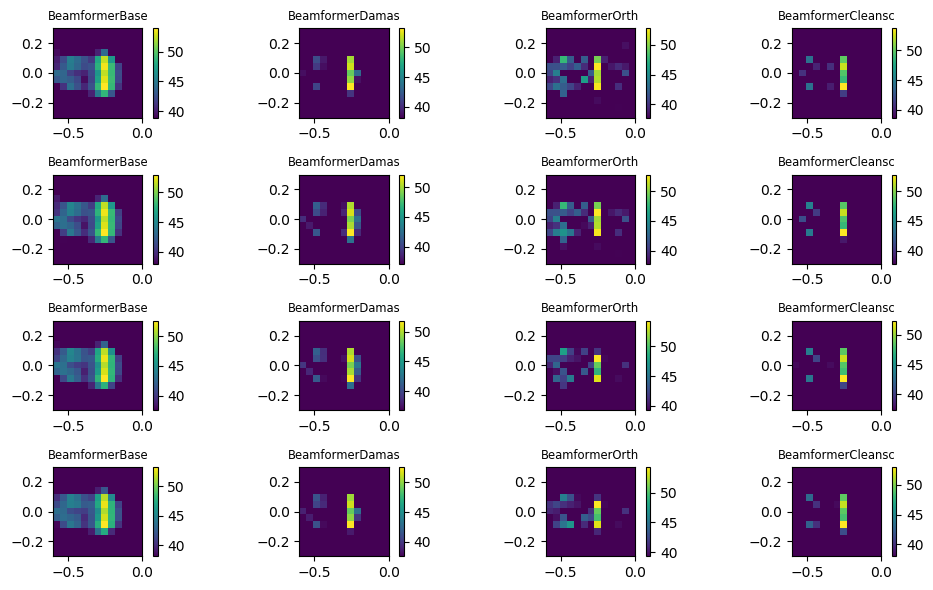Airfoil in open jet – Steering vectors¶
Demonstrates different steering vectors in Acoular and CSM diagonal removal with the same setup as in Airfoil in open jet – Beamforming.
It needs the measured timeseries data in example_data.h5 and calibration in example_calib.xml. Both files should reside in the same directory as the example_airfoil_in_open_jet_steering_vectors.py script.
The script produces two figures:

Results for different frequency domain beamformers with diagonal removal¶ |

Results for different frequency domain beamformers without diagonal removal¶ |
# -*- coding: utf-8 -*-
"""
Example "Airfoil in open jet -- steering vectors" for Acoular library.
Demonstrates different steering vectors in Acoular
and CSM diagonal removal with same setup as in example
"Airfoil in open jet -- beamformers".
Uses measured data in file example_data.h5,
calibration in file example_calib.xml,
microphone geometry in array_56.xml (part of Acoular).
Copyright (c) 2006-2019 Acoular Development Team.
All rights reserved.
"""
from __future__ import print_function
# imports from acoular
import acoular
from acoular import L_p, Calib, MicGeom, PowerSpectra, Environment,\
RectGrid, BeamformerBase, BeamformerEig, BeamformerOrth, BeamformerCleansc, \
MaskedTimeSamples, BeamformerDamas, SteeringVector
# other imports
from os import path
from pylab import figure, subplot, imshow, show, colorbar, title, tight_layout
# files
datafile = 'example_data.h5'
calibfile = 'example_calib.xml'
micgeofile = path.join( path.split(acoular.__file__)[0],'xml','array_56.xml')
#octave band of interest
cfreq = 4000
#===============================================================================
# first, we define the time samples using the MaskedTimeSamples class
# alternatively we could use the TimeSamples class that provides no masking
# of channels and samples
#===============================================================================
t1 = MaskedTimeSamples(name=datafile)
t1.start = 0 # first sample, default
t1.stop = 16000 # last valid sample = 15999
invalid = [1,7] # list of invalid channels (unwanted microphones etc.)
t1.invalid_channels = invalid
#===============================================================================
# calibration is usually needed and can be set directly at the TimeSamples
# object (preferred) or for frequency domain processing at the PowerSpectra
# object (for backwards compatibility)
#===============================================================================
t1.calib = Calib(from_file=calibfile)
#===============================================================================
# the microphone geometry must have the same number of valid channels as the
# TimeSamples object has
#===============================================================================
m = MicGeom(from_file=micgeofile)
m.invalid_channels = invalid
#===============================================================================
# the grid for the beamforming map; a RectGrid3D class is also available
# (the example grid is very coarse)
#===============================================================================
g = RectGrid(x_min=-0.6, x_max=-0.0, y_min=-0.3, y_max=0.3, z=0.68,
increment=0.05)
#===============================================================================
# for frequency domain methods, this provides the cross spectral matrix and its
# eigenvalues and eigenvectors, if only the matrix is needed then class
# PowerSpectra can be used instead
#===============================================================================
f = PowerSpectra(time_data=t1,
window='Hanning', overlap='50%', block_size=128, #FFT-parameters
ind_low=8, ind_high=16) #to save computational effort, only
# frequencies with index 1-30 are used
#===============================================================================
# the environment, i.e. medium characteristics
# (in this case, the speed of sound is set)
#===============================================================================
env = Environment(c = 346.04)
# =============================================================================
# a steering vector instance. SteeringVector provides the standard freefield
# sound propagation model in the steering vectors.
# =============================================================================
st = SteeringVector(grid=g, mics=m, env=env)
#===============================================================================
# beamformers in frequency domain
#===============================================================================
bb = BeamformerBase(freq_data=f, steer=st, r_diag=True)
bd = BeamformerDamas(beamformer=bb, n_iter=100)
be = BeamformerEig(freq_data=f, steer=st, r_diag=True, n=54)
bo = BeamformerOrth(beamformer=be, eva_list=list(range(38,54)))
bs = BeamformerCleansc(freq_data=f, steer=st, r_diag=True)
#===============================================================================
# plot result maps for different beamformers in frequency domain
#===============================================================================
fi = 1 #no of figure
for r_diag in (True,False):
figure(fi,(10,6))
fi +=1
bb.r_diag = r_diag
be.r_diag = r_diag
bs.r_diag = r_diag
i1 = 1 #no of subplot
for steer in ('true level', 'true location', 'classic', 'inverse'):
st.steer_type = steer
for b in (bb, bd, bo, bs):
subplot(4,4,i1)
i1 += 1
map = b.synthetic(cfreq,1)
mx = L_p(map.max())
imshow(L_p(map.T), vmax=mx, vmin=mx-15, origin='lower',
interpolation='nearest', extent=g.extend())
print(b.steer.steer_type)
colorbar()
title(b.__class__.__name__,fontsize='small')
tight_layout()
# only display result on screen if this script is run directly
if __name__ == '__main__': show()